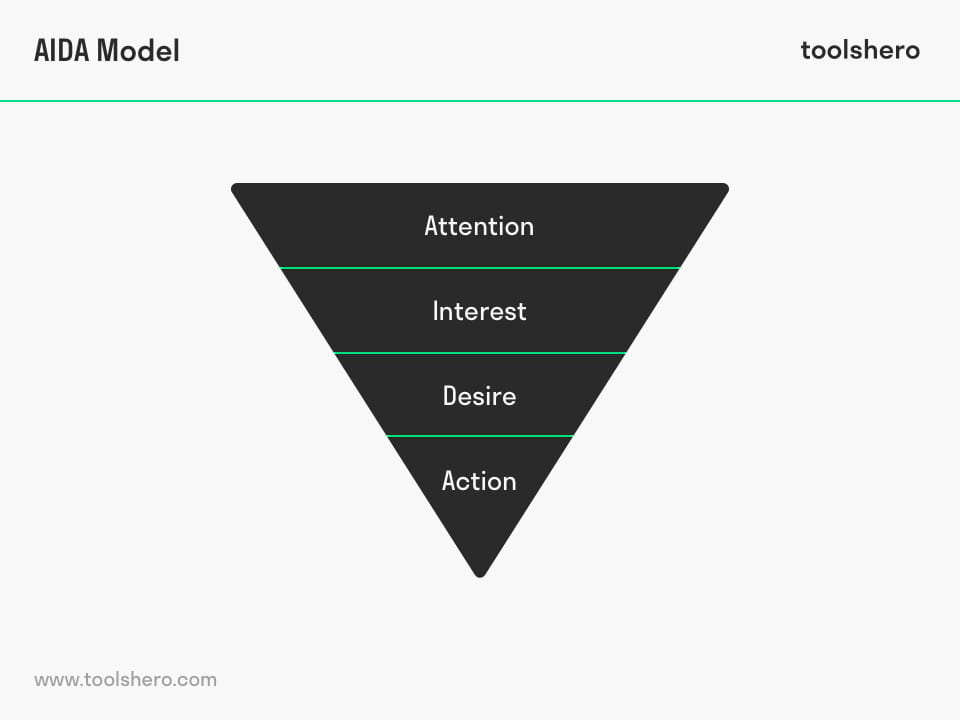AIDA Model explained including an example

AIDA Model: this article explains the AIDA Model in a practical way. Here you will find exactly what the AIDA model is, an example of it in practice and an explanation of the elements, steps and applications of the model. Enjoy reading!
What is the AIDA model and formula?
The AIDA Model is a universally praised means / formula within the advertising, like advertising messages and marketing sector to persuade potential customers to buy a product and / or service.
Today, the AIDA model is used in almost every advertisement or commercial. The basic principles of this method were devised by Elias St. Elmo Lewis in the late 1800s.
Elias St. Elmo Lewis was an American businessman. His main goal was to optimise sales pitches, specifically the interaction between buyer and seller. Lewis is considered a pioneer in science-based methods and techniques for advertising and sales processes.
For Lewis, it was also very important to view advertising as a type of training. The training should be useful for the participant, .i.e. the potential customer. He developed the advertising theory based on his extensive past experience and became the marketing head at several large organisations.
AIDA model: what do the letters AIDA stand for?
AIDA is the acronym for the terms Attention, Interest, Desire and Action. Starting with Attention, the model must be followed step-by-step and ends with Action.
The AIDA model explained
In effect, the AIDA model follows the entire customer journey like a marketing funnel through the abovementioned stages of attention, interest, desire and action.
Hence the model depicts the cognitive stages the customer goes through during the service or product purchasing process. This is why it is sometimes referred to as the purchasing funnel. In the funnel, the buyer and seller repeatedly go back and forth to guide the customer towards the final purchase decision.
Although the accuracy of the model is still very high, nowadays it is not solely the relationship between buyer and seller that plays a role in the purchasing process. The rise of social media has seen this expand to encompass a variety of channels, networks and communities.
AIDA model in practice
Only then this model has a good chance of success. Whether it is a direct mail or an extended television commercial, the AIDA model has proved itself over time.

Figure 1 – AIDA model / funnel
Attention
The attention of a potential customer must be drawn before they make a purchase decision. This decision could be made based on colour, typography, sound, image or the use of celebrities. Texts can be used too. A good slogan can attract attention to a product immediately.
Some questions you can ask yourself during this phase are:
- Which tools and platforms can we use?
- What kind of messages do we want to convey?
- How can we make our customers aware of our new products or services?
- How is the brand awareness campaign put together?
Interest
When attention has been drawn to the product/service, a customer’s interest will be piqued. The interest in the product/service can only be piqued after the unique selling points (USPs) have been highlighted. These points of sale must be convincing enough for the potential buyer to purchase the product/service. In combination with price, guarantee and terms of delivery, USP s provide an important basis for generating a customer’s interest.
Some questions you can ask yourself during this phase are:
- How can we capture the interest of our customers?
- How effective is our content marketing strategy?
- How do we share information?
Desire
In this step interest turns into desire. The potential customer must crave for the product and / or service as it were and they must have the idea that they cannot do without it any more.
To win the customer over, certain product features could be exaggerated so that the product and/or service will become more valuable than that of the competition. Psychological aspects (somatic markers) can play a role in which a brand name can make an important contribution to the Desire factor.
Some questions you can ask yourself during this phase are:
- What makes our product or service so special and unique?
- How do we deal with customers?
Action
This final stage is about the customer taking action. This results in the customer buying the product and/or service. As an extra stimulus, a special offer will make it a just a little more attractive for the customer to buy the product.
It is also important that the customer knows now where they can buy the product and/or service. In addition to the purchase, registering for a newsletter, requests for a brochure or other forms of responsive action are active forms of action. When data of potential customers (leads) are known, it is much easier to land them as a paying customer.
Some questions you can ask yourself during this phase are:
- What types of call-to-action do we use?
- Is it easy for consumers out there to cross our path?
AIDA model example
In the following example, the fictitious Ozone hairdressing chain is launching a new salon. The company follows the four steps in the model and links various courses of action and outcomes to each step.
Step 1: Awareness
The management at Ozone knows that raising public awareness is an important factor for the successful launch of the new salon. This is why they start a campaign a few months prior to the launch.
The campaign promoted various elements of the salon, such as the different stylists, low prices, qualifications, quality and more. The launch was also announced on social media as part of the campaign.
Step 2: Generating interest
After raising awareness among the general public, it is important that Cosmo sparks genuine interest among the same audience.
This interest should encourage customers to actually come to the salon following the launch. Which is why the hairdressers decide to run a direct email marketing campaign. Several emails are sent out giving away free haircuts or other treatments.
Step 3: Desire
Just before the new salon opens, the management organises exclusive events. These types of events are used to generate a buzz among the local community and get people excited about visiting the salon during the launch and afterwards.
Step 4: Action
Cosmo kappers uses Call-to-Actions (CTA) in a variety of ways to get people to visit the salon. An appeal is made to customers on Facebook to register because the salon is expected to be extremely busy. In addition, the website promotes making an online appointment, and local advertisements are placed with discount cards for new clients who do schedule an appointment.
While customer retention is not addressed in this example, there are several ways to increase customer loyalty to the salon. A very common way is subscribing to mailing lists to receive emails about news, offers and events.
AIDA online marketing model
As mentioned earlier, the AIDA model is suitable for both online and offline marketing. The framework is specifically designed to guide customers through the different stages of the funnel and to prompt them to act.
The overview below shows which matters are important for each stage of the AIDA process when the model is applied to online marketing or digital marketing.
Awareness
During the awareness stage, various methods and techniques can be used to actually raise awareness. Where online marketing is concerned, there are some basic rules that apply.
The first one is that a site or page does not exist if visitors can’t find it. Apart from that, by using visualisations, certain elements can be given more prominence than other, less important issues.
Users and visitors don’t tend to have a lot of patience online. Every time there is a delay or an extra step, it leads to delay, frustration, and eventual waste.
This is why page speed, or loading speed, and visual prioritisation are two of the most important things to consider when it comes to raising customer awareness in digital marketing.
Interest
For companies using online marketing techniques, this stage of the AIDA model, interest, is extremely critical. It primarily concerns knowing and respecting precisely what the visitor wants. There are a few basic rules involved in this as well.
Firstly, it is essential to know exactly who the visitors are. After that, it must be established what their request is exactly. Various techniques are available for this. For example, qualitative software is available to measure and ask visitors what they want.
This helps to understand how the site or page can be improved. There are also tools like Google Analytics. These can be used to find out more about the demographics of visitors, the keywords they use, etc.
Create desire
A number of things are also important in this phase. First of all the visitor needs to feel valued. It is also the visitor who should have full control over the whole experience.
The information that is provided must convince the visitor that the website has everything they are looking for. If the visitor is confident that this is indeed the case, then a lot can be gained during this phase of the funnel.
Action
The visitors have been convinced during the previous phase that the page has exactly what they are looking for. The next task is the actual conversion: convincing them to do business with you. This is not easy.
Consumers have access to more and more information and are getting smarter thanks to the wide availability of online price comparisons.
It is possible to overcome these challenges, although it is not that simple. First of all, get out of the visitor’s way. This means: clear the way for the visitor to finally pull the trigger, by not displaying distracting content in the online shopping cart, etc.
Further application
The model itself is already 100 years old and it is often updated and adjusted. Today, the S of Satisfaction is often added to the model. This factor is also the determinant for repeat buys of the existing customer whereas positive word of mouth advertising will contribute to a larger clientèle.
The suggestion has been made to add the letter C for Conviction to the model. Opinions are divided about this, because Interest is also about convincing the customer with the aid of the unique selling points of the product and/or service.
Conviction would go beyond this and would follow the stage of Interest created by stimuli in commercials.
Many applications of the AIDA Model
One thing is certain. This model has many applications and is used as a marketing tool in both the commercial and non-commercial sectors.
Nowadays, libraries would like to approach more people and will pull out all the stops to increase their user groups and borrowers in which they make use of the AIDA Model.
From websites to advertisements and from billboards to catalogues, AIDA remains very useful.
It’s Your Turn
What do you think? Is the AIDA Model applicable in today’s modern economy and marketing? Do you recognize the practical explanation or do you have more suggestions? What are your success factors for the good AIDA Model set up?
Share your experience and knowledge in the comments box below.
More information
- Jobber, D. & Ellis-Chadwick, F. (2013). Principles and Practices of Marketing. McGraw-Hill Education.
- Mohammadi, S., Esmaeily, N., & Salehi, N. (2012). Prioritization of promotion tools based on AIDA model by Analytic Hierarchy process in production sector of sport industry. Archives of Applied Science Research, 4(4), 1670-1675.
- Paul Peter, J. & Donnelly, J. H. (2006). Marketing Management. McGraw-Hill/Irwin.
- St. Elmo Lewis, E. (1908). Financial Advertising. (The History of Advertising). Levey Brothers.
How to cite this article:
Mulder, P. (2012). AIDA Model. Retrieved [insert date] from Toolshero: https://www.toolshero.com/marketing/aida-model/
Original publication date: 12/07/2021 | Last update: 04/12/2023
Add a link to this page on your website:
<a href=”https://www.toolshero.com/marketing/aida-model/”>Toolshero: AIDA Model</a>












